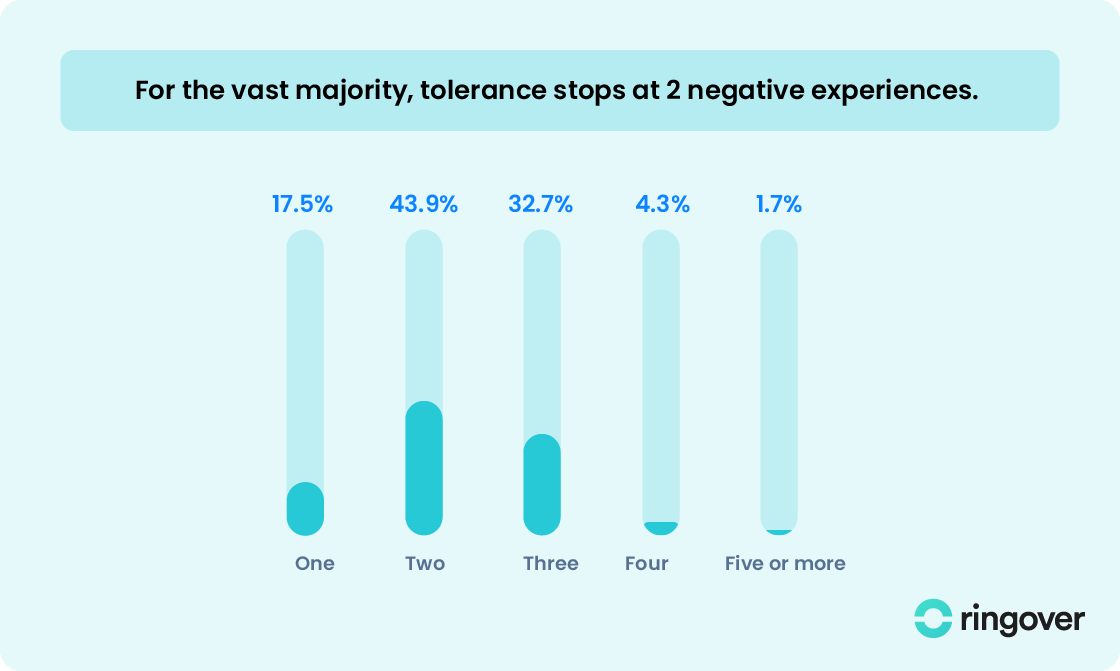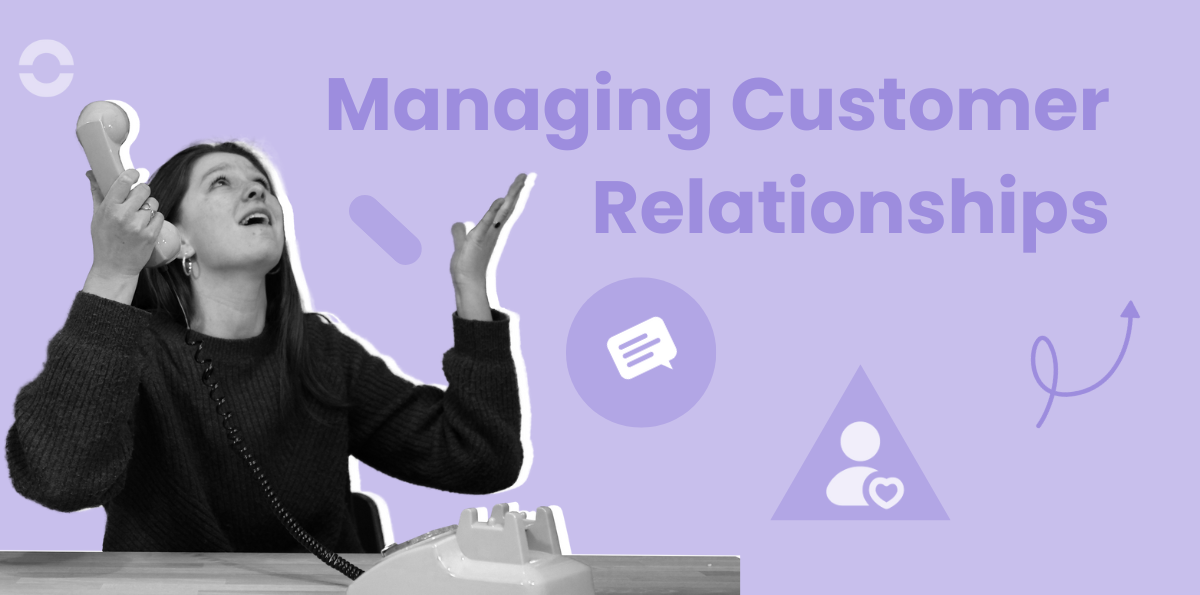Summary
- What is a difficult customer?
- Management of the difficult customer: identifying the warning signals
- What tools help identify and manage difficult customers?
- Difficult customer: 4 tips for good management
- How to train to manage difficult customers?
- Ringover supports you in managing difficult customers
- Managing Customer Relationships FAQ
The interactions with difficult customers can prove to be trying, consume a lot of time and energy, and potentially deteriorate your reputation if not handled well.
This article addresses the strategies effective for managing these delicate situations, responding effectively to the needs of each one while maintaining the quality of your service.
In this guide, discover all about the management of difficult customers, including:
- The definition of a difficult customer.
- How to identify the warning signals.
- The tools to anticipate and manage these situations.
- Four essential tips for optimal management.
- The value of specialised training.
- Techniques to reframe disrespectful behaviour.
- Common profiles of difficult customers.
- The potential impacts on your business.
What is a difficult customer?
A difficult customer is usually characterised by the excessive expression of dissatisfaction, frustration, or anger, sometimes in an inappropriate or abusive manner. Their behaviour can be aggressive, disrespectful, threatening, or even manipulative, towards the staff or the company itself.
These customers can also appear indecisive, demanding, impatient, or constantly unsatisfied, thus making the business relationship arduous.
Several factors can lead to this difficulty:
- Problems related to the product or service (defects, delays, non-compliance, etc.),
- Deficient communication or a misunderstanding between the customer and the company,
- Excessive and sometimes unrealistic expectations or demands,
- Tense personal or professional circumstances (stress, fatigue, emotions...),
- A particularly conflictual personality or temperament.
It is important to note that a difficult customer is not synonymous with a bad customer. They may be a loyal customer, a potential new customer, or a customer with a certain influence. Sometimes, behind these behaviours, there are real needs, expressions of dissatisfaction, or even constructive suggestions.

What to remember 💡
It is crucial to be able to distinguish between the message and the manner in which it is delivered, thus avoiding perceiving difficult reactions as personal attacks.
Management of the difficult customer: identifying the warning signals
To effectively manage a difficult customer, the first step is to identify them. Certain signals, whether verbal or non-verbal, can indicate a risk of conflict with a customer. Recognizing these signals is essential to quickly adopting an appropriate attitude to defuse the tension.
Verbal warning signals include the phrases or specific words used by the customer to express their dissatisfaction, frustration, or anger. Here are some examples:
- "I am not satisfied at all."
- "This is unacceptable."
- "Are you kidding me?"
- "I want to speak to your manager."
- "I will leave a negative review on social media."
As for non-verbal signals, they manifest through gestures, facial expressions, or a tone of voice revealing the customer's emotion. For example, the customer might:
- Raise their voice, or even shout.
- Cross their arms or tap their feet.
- Sigh or roll their eyes.
- Bare their teeth or frown.
- Wave their hands or point a finger.
In the presence of these warning signals, it is crucial to act quickly and calmly. Avoid engaging in a power struggle, directly contradicting the customer, or provoking them. The objective is to understand the source of their dissatisfaction, show empathy, and offer them a tailored solution. We will delve into more detail on ways to defuse tense situations.
What tools help identify and manage difficult customers?
To better understand and manage difficult customers, several tools are available to you. They are designed to enhance your communication, listening, and problem-solving abilities.
These resources, whether techniques, software, or training, aim for a refined understanding of customer needs and expectations. The goal is to achieve customer satisfaction and customer loyalty.
Here are a few tools to help you achieve that goal.
Assertive communication ✅
This approach promotes the expression of your opinions, feelings, and needs in a clear, direct, and respectful manner. It is free of aggression and passivity, thus promoting self-assertion and respect for others, creating a climate of trust and cooperation, and helping to prevent or resolve conflicts.
CRM (Customer Relationship Management) ✅
This software is essential for optimising customer relationship management. It centralises customer information, tracks their interactions with the company, personalised offers and services, and analyses their satisfaction and loyalty.
Training in managing difficult customers ✅
This training is crucial for acquiring the skills and attitudes needed when facing difficult customers. It teaches the recognition of different types of difficult customers, the use of effective communication strategies, maintaining professionalism and patience, and the application of problem-solving techniques.
Conversational analysis ✅
Conversation intelligence software can help customer service teams manage difficult customers by providing detailed information on past interactions. Practically, it allows for the study and evaluation of conversations between customers and agents across different channels. For example, with Empower by Ringover, calls are transcribed and summarised automatically, and agents can access precise data on the progression and content of each conversation:
- Speaking turns
- Monologues
- Topics covered
Empower offers a tagging system that allows you to identify the keywords of your choice. You can do this on all calls between your customers and your teams. Thus, you can check at a glance the relevance of your agents' speech and anticipate potential problems that could generate customer dissatisfaction.
The teams can thereby identify behaviour patterns, understand specific customer issues, and adapt accordingly to improve the experience offered.
This technique allows for spotting patterns in conversations that might indicate customer dissatisfaction or confusion, enabling customer service teams to intervene proactively and resolve issues. Conversational analysis also contributes to the training of customer service agents by showing them examples of successful management of difficult situations.
Difficult customer: 4 tips for good management
Managing a difficult customer is undoubtedly a challenge, but with the right tools in hand, it becomes a largely surmountable task. Here are four practical tips to achieve this:
1. Show empathy and adopt clear communication
Empathy, which represents the ability to put oneself in another's shoes, is crucial for building a trustful relationship. To achieve this, it is essential to listen actively and communicate positively and constructively. Adopting clear communication means being precise and consistent, eliminating technical jargon, and avoiding any ambiguity to facilitate understanding.
2. Remain honest
Honesty is the foundation of a lasting relationship with your customers. This means keeping your commitments, admitting your mistakes, and being transparent. Never make unrealistic promises, and take the time to explain problematic situations while offering solutions. Apologise if necessary, and consider a commercial gesture as a sign of goodwill.
Regarding customer tolerance, note that it takes an average of two bad experiences for a customer to decide to switch brands/services.

3. Personalise your approach
Each customer is a unique case; therefore, a personalised approach is essential. This involves adjusting your communication according to the customer, offering tailor-made solutions, and demonstrating your understanding of their specific needs, thereby affirming their value as a partner.
4. Use feedback to improve
Feedback is essential for evaluating and improving the quality of your service. Encourage your customers to share their opinions, whether through satisfaction surveys, social media, or direct interviews. This feedback, whether positive or negative, should be carefully analysed to identify areas for improvement and strengthen your customer relationship.
Get data-driven insights into how agents handle customers, difficult or not, thanks to in-depth metrics. You can understand how quickly agents respond, how much time spent with customers, and the overall service level provided.
How to train to manage difficult customers?
Training aimed at managing difficult customers aims to improve the skills and behaviours of professionals often confronted with unhappy, aggressive, or demanding customers. They offer crucial tools and techniques for effective communication, adequate emotional management, relevant problem-solving, and successful customer retention.
Are these training sessions really beneficial? Absolutely, because they offer multiple benefits not only for professionals but also for customers and businesses. The benefits include:
- An increase in confidence and self-esteem among employees, enabling them to handle difficult situations with more assurance and competence.
- A significant improvement in the quality of the customer relationship, making these exchanges more respectful, constructive, and lasting.
- A reduction in stress and a decreased risk of burnout among professionals, thanks to better strategies for emotional management and maintaining personal and professional balance.
- An increase in customer satisfaction and retention, with customers feeling heard, understood, and valued.
- A strengthening of the company's image and reputation, which stands out for its professionalism and ability to handle delicate situations.
Investing in training to manage difficult customers is therefore a profitable investment, contributing to the development of professional skills, customer loyalty, and the sustainability of the company.
You can conduct these training sessions internally through dedicated workshops based on real situations recorded using your telephony and conversational analysis tools.
Ringover supports you in managing difficult customers
Ringover transforms the management of demanding customers into an easy task. Discover what Ringover offers:
- A versatile cloud VoIP system, giving you the freedom to make and receive calls, text messages, WhatsApp messages, and conduct video conferences, all from your computer or smartphone, regardless of your location.
- Powerful artificial intelligence designed to refine your communication, analyse your performance, and promote continuous learning through its conversational analysis solution, Empower by Ringover. Among the tools offered are automatic call transcription, sentiment analysis, insights, and call summaries.
In short, Ringover simplifies the prevention and management of difficult interactions with your customers, significantly improving the quality of your customer relationships, while boosting your productivity, satisfaction, and ultimately, your revenue.
Curious to see how Ringover can revolutionise your management of difficult customers? Start your seven-day trial with no obligation. One thing is certain: You won't regret it!
Managing Customer Relationships FAQ
What are the 4 C's of customer relationship management?
The 4 C's help to orient your customer relationship strategy, and consist of: customer experience, conversation, content, and collaboration.
How to redirect an openly disrespectful customer?
When dealing with a customer who is disrespectful, insulting, threatening, or harassing, adopting a calm and polite attitude is not always enough. It is essential to know how to reframe this person to make them understand that their behaviour is unacceptable.
Here are the steps to follow:
- Stay firm without being intimidated: When facing a disrespectful customer, it is crucial to maintain your calm and authority. Do not apologise if you have done nothing wrong, avoid justifying yourself unnecessarily, and do not appear submissive. Be clear about your position and your rights, and do not give in to unreasonable demands or manipulations.
- Establish clear boundaries: It is important to make the customer understand that the business relationship is governed by rules that they must respect. Inform them, for example, that you will not respond to their calls or messages outside of business hours, that discounts or favours require a justifiable reason, and that you will not tolerate disrespectful behaviour.
- Use "I" statements: To reframe a customer in a non-aggressive manner, using "I" statements is recommended as it allows you to express your feelings or point of view without accusing or judging the customer. Using "you" can be perceived as a reproach or attack, risking to escalate the conflict.
- Offer a solution or consider ending the relationship: After reframing the customer, it is crucial to propose a solution to resolve the issue or decide to stop working together if no solution is possible. If you choose the first option, ensure that the customer accepts the new conditions and that you can implement them. In case of a termination, be careful to respect contractual clauses and protect yourself legally. Your telephony solution can help cover you in case of a dispute if you record the calls.
What are the different types of difficult customers?
Difficult customers present a variety of profiles, motivations, and behaviours. Recognizing and categorising these types is crucial for effectively adjusting communication and problem-solving strategies.
Here are some categories of difficult customers and the strategies to manage them:
- The Aggressive Customer: Characterised by hostility, they can be violent, abusive, or threatening, seeking to intimidate. When dealing with them, maintain your calm, stay firm and professional, signal that their behaviour is unacceptable, and propose immediate resolutions, seeking their agreement.
- The Egocentric Customer: Arrogant and pretentious, they feel superior and disdain rules. To manage them, avoid flattery or contradiction, show respect and recognition while affirming your authority. Offer tailored solutions or services that enhance their image.
- The Critical Customer: Sceptical and mistrustful, they constantly question your statements looking for errors. Don't justify yourself; instead, provide concrete evidence (proofs, testimonials, data) supporting your proposals, and engage them with open-ended questions to better understand their expectations.
- The Indecisive Customer: Often lost or quick to change their mind due to confusion. Simplify decisions for them by clearly listing the advantages and disadvantages of options, advise them on the best one, and set a deadline to encourage them to decide.
- The Impatient Customer: Desires immediate satisfaction and struggles to tolerate any delay. Ensure a quick response and always be available, offering transparent information on procedures and timelines, and performing regular follow-ups to reassure them.
What impacts can difficult customers have on your business?
Difficult customers represent a major challenge, not just for the professionals in direct contact with them, but for the entire company. Their influence on your business can be negative or positive, depending on how you choose to approach them.
Negative Impacts:
- Customer Satisfaction and Retention: Difficult customers can compromise satisfaction and retention, damaging the reputation and image of your company.
- Employee Morale and Motivation: Their behaviour can affect the morale and motivation of your teams.
- Profitability and Sustainability: They can jeopardise the profitability and sustainability of your operations.
- For example, a dissatisfied customer may share their discontent, potentially discouraging prospects. An aggressive customer can negatively impact employee well-being and productivity. Additionally, meeting a difficult customer's demands can be costly, reducing margins and competitiveness.
Positive Impacts:
- Identifying Weaknesses: A critical customer can push you to identify and correct your weaknesses, improving service quality.
- Simplifying and Customizing Offers: An indecisive customer can prompt you to simplify or customise your offer, making it more attractive and better suited to market demands.
- Optimising Processes: An impatient customer can be the catalyst for optimising your processes and reducing delivery times, thereby increasing efficiency and responsiveness.
- The impact of difficult customers on your business thus primarily depends on your ability to manage them positively and constructively. It is crucial to have the appropriate tools, techniques, and training to handle these situations well and to perceive these challenges as opportunities for improvement rather than obstacles.



